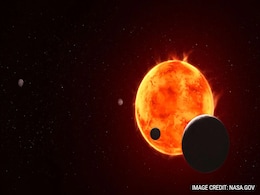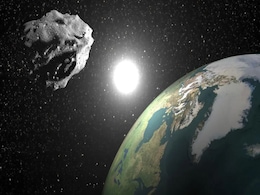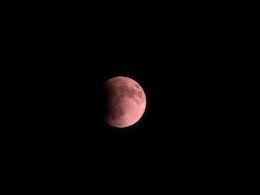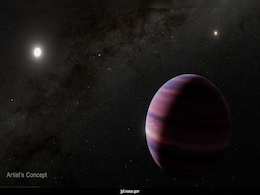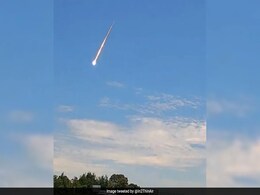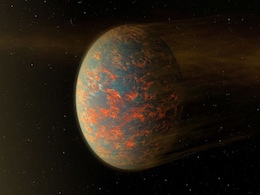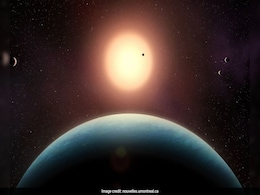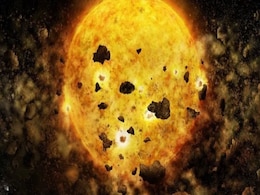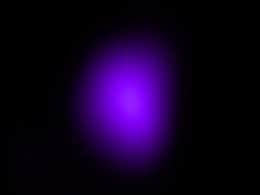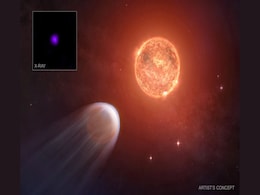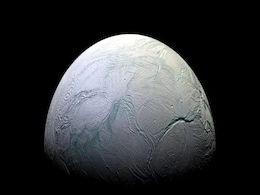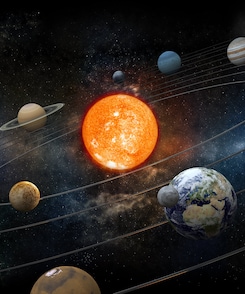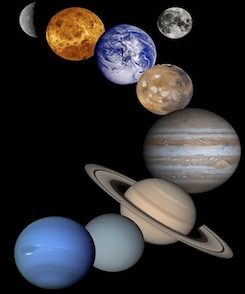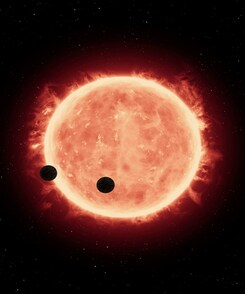Earth Planets
- All
- News
- Videos
- Web Stories
-

Not Like Venus Or Mars, Distant Exoplanet May Have Atmosphere Like Earth's
- Friday September 19, 2025
- World News | Edited by NDTV News Desk
A distant exoplanet might have an atmosphere similar to Earth's, early observations from the James Webb Space Telescope (JWST) suggest. It is part of a group of planets orbiting a star called TRAPPIST-1, about 40 light-years away from Earth.
-
 www.ndtv.com
www.ndtv.com
-

New 'Quasi-Moon' Discovered in Earth Orbit May Have Been Hiding There for Decades
- Sunday September 14, 2025
- Written by Gadgets 360 Staff
Astronomers have identified asteroid 2025 PN7 as a possible quasi-moon of Earth, trailing our planet for nearly 70 years. At just 62 feet wide, it is the smallest and least stable quasi-satellite detected so far. Researchers believe advanced observatories like the Vera Rubin Observatory could uncover more hidden companions in Earth-like orbits
-
 www.gadgets360.com
www.gadgets360.com
-

'Blood Moon' Rises, Rare Total Lunar Eclipse Lights Up The Sky
- Sunday September 7, 2025
- India News | Edited by NDTV News Desk
Stargazers were in for a treat as they turned their gaze towards the Moon Sunday night to witness a rare 'Blood Moon' or the total lunar eclipse, the longest since 2022, visible acrossAsia and swathes of Europe and Africa.
-
 www.ndtv.com
www.ndtv.com
-

James Webb Spots Bizarre Planet-Forming Disk Full of Carbon Dioxide
- Friday September 5, 2025
- Written by Gadgets 360 Staff
The James Webb Space Telescope has spotted a bizarre planet-forming disk dominated by carbon dioxide where water is almost absent. This rare finding, in star system XUE 10 within NGC 6357, challenges current models of planetary formation and may reshape our understanding of habitable worlds.
-
 www.gadgets360.com
www.gadgets360.com
-

A New 'Earth' Next Door? Scientists Detect Possible Habitable Planet Around Closest Sun-Like Star
- Friday August 15, 2025
- Science | Edited by Nikhil Pandey
Astronomers using JWST have detected a giant exoplanet in the habitable zone of Alpha Centauri A, our nearest Sun-like star.
-
 www.ndtv.com
www.ndtv.com
-

NASA Missions Uncover a Diverse Galaxy of Super-Earths, Raising New Questions About Planetary Evolution
- Thursday August 14, 2025
- Written by Gadgets 360 Staff
Super-Earths are among the most common planets in the galaxy, yet none exist in our solar system. Larger than Earth but smaller than Neptune, they range from ocean-covered worlds to scorched, atmosphere-less rocks. Some orbit within habitable zones, making them prime candidates for life. NASA’s Kepler and TESS missions, along with upcoming telesc...
-
 www.gadgets360.com
www.gadgets360.com
-

Habitable Zone Explained: The ‘Goldilocks Zone’ Where Life-Friendly Planets May Exist
- Tuesday August 12, 2025
- Written by Gadgets 360 Staff
The habitable zone, or “Goldilocks zone”, is the region around a star where conditions allow liquid water to exist. Varying with star type, this zone is key in the search for life. Earth’s location in the Sun’s habitable zone has made life possible, and astronomers seek similar rocky exoplanets in other systems to explore the possibility of...
-
 www.gadgets360.com
www.gadgets360.com
-

Scientists Explore Role of Space Radiation in Powering Alien Microbial Life
- Wednesday August 6, 2025
- Written by Gadgets 360 Staff
A new study proposes that life may exist far from sunlight in a “radiolytic habitable zone” deep beneath the icy surfaces of Mars, Europa, and Enceladus. Cosmic rays, which can penetrate rock and ice, break water molecules apart to release hydrogen, oxygen, and energy-rich electrons. These can fuel microbes in subsurface water, much like bacter...
-
 www.gadgets360.com
www.gadgets360.com
-

Doomed Exoplanet TOI-2109b Spirals Toward Its Star with Three Possible Fates
- Monday July 28, 2025
- Written by Gadgets 360 Staff
The gas giant TOI-2109b, over five times Jupiter’s mass, is spiraling closer to its star in a rare planetary death spiral. With a 16-hour orbit and blistering heat, the exoplanet could either plunge into its host star, be torn apart by tidal forces, or evolve into a rocky super-Earth through photoevaporation. NASA’s TESS and ESA’s Cheops data...
-
 www.gadgets360.com
www.gadgets360.com
-

Chandra Spots Distant Baby Planet Losing Its Atmosphere Under Intense X-ray Assault
- Saturday July 19, 2025
- Written by Gadgets 360 Staff
NASA’s Chandra X-ray Observatory has captured a rare glimpse of TOI 1227 b, a young, Jupiter-sized exoplanet losing its atmosphere under intense stellar radiation. Just 8 million years old, the planet is shrinking rapidly as X-rays strip away its mass. Scientists warn it may become a barren rocky core in about a billion years.
-
 www.gadgets360.com
www.gadgets360.com
-

Young Exoplanet Spotted Shedding Atmosphere Under Stellar Radiation
- Thursday July 17, 2025
- Written by Gadgets 360 Staff
NASA’s Chandra X-ray Observatory and Hubble Space Telescope have captured a dramatic cosmic event: a baby exoplanet, TOI 1227 b, is being stripped of its atmosphere by powerful X-rays from its host star. Only 8 million years old and orbiting a red dwarf, this Jupiter-sized planet is losing gas at a rate equal to Earth’s entire atmosphere every ...
-
 www.gadgets360.com
www.gadgets360.com
-

This Arctic Town Has The World's Northernmost Brewery And A Ban On Death
- Thursday July 17, 2025
- Travel | Written by Nikita Nikhil, Edited by Shubham Bhatnagar
Some places on Earth are wild in more ways than one, and Svalbard Bryggeri in Norway - the northernmost brewery on the planet - is one of them.
-
 www.ndtv.com/travel
www.ndtv.com/travel
-

Crystalline Ice Discovered in Space: New Study Reveals Hidden Order in Cosmic Ice
- Tuesday July 15, 2025
- Written by Gadgets 360 Staff
A groundbreaking study from University College London and the University of Cambridge reveals that water ice in space, long believed to be completely amorphous due to extreme cold, may actually contain up to 25% crystalline structure. Simulations and X-ray diffraction experiments confirm the presence of nanocrystals in so-called low-density amorpho...
-
 www.gadgets360.com
www.gadgets360.com
-

Not Like Venus Or Mars, Distant Exoplanet May Have Atmosphere Like Earth's
- Friday September 19, 2025
- World News | Edited by NDTV News Desk
A distant exoplanet might have an atmosphere similar to Earth's, early observations from the James Webb Space Telescope (JWST) suggest. It is part of a group of planets orbiting a star called TRAPPIST-1, about 40 light-years away from Earth.
-
 www.ndtv.com
www.ndtv.com
-

New 'Quasi-Moon' Discovered in Earth Orbit May Have Been Hiding There for Decades
- Sunday September 14, 2025
- Written by Gadgets 360 Staff
Astronomers have identified asteroid 2025 PN7 as a possible quasi-moon of Earth, trailing our planet for nearly 70 years. At just 62 feet wide, it is the smallest and least stable quasi-satellite detected so far. Researchers believe advanced observatories like the Vera Rubin Observatory could uncover more hidden companions in Earth-like orbits
-
 www.gadgets360.com
www.gadgets360.com
-

'Blood Moon' Rises, Rare Total Lunar Eclipse Lights Up The Sky
- Sunday September 7, 2025
- India News | Edited by NDTV News Desk
Stargazers were in for a treat as they turned their gaze towards the Moon Sunday night to witness a rare 'Blood Moon' or the total lunar eclipse, the longest since 2022, visible acrossAsia and swathes of Europe and Africa.
-
 www.ndtv.com
www.ndtv.com
-

James Webb Spots Bizarre Planet-Forming Disk Full of Carbon Dioxide
- Friday September 5, 2025
- Written by Gadgets 360 Staff
The James Webb Space Telescope has spotted a bizarre planet-forming disk dominated by carbon dioxide where water is almost absent. This rare finding, in star system XUE 10 within NGC 6357, challenges current models of planetary formation and may reshape our understanding of habitable worlds.
-
 www.gadgets360.com
www.gadgets360.com
-

A New 'Earth' Next Door? Scientists Detect Possible Habitable Planet Around Closest Sun-Like Star
- Friday August 15, 2025
- Science | Edited by Nikhil Pandey
Astronomers using JWST have detected a giant exoplanet in the habitable zone of Alpha Centauri A, our nearest Sun-like star.
-
 www.ndtv.com
www.ndtv.com
-

NASA Missions Uncover a Diverse Galaxy of Super-Earths, Raising New Questions About Planetary Evolution
- Thursday August 14, 2025
- Written by Gadgets 360 Staff
Super-Earths are among the most common planets in the galaxy, yet none exist in our solar system. Larger than Earth but smaller than Neptune, they range from ocean-covered worlds to scorched, atmosphere-less rocks. Some orbit within habitable zones, making them prime candidates for life. NASA’s Kepler and TESS missions, along with upcoming telesc...
-
 www.gadgets360.com
www.gadgets360.com
-

Habitable Zone Explained: The ‘Goldilocks Zone’ Where Life-Friendly Planets May Exist
- Tuesday August 12, 2025
- Written by Gadgets 360 Staff
The habitable zone, or “Goldilocks zone”, is the region around a star where conditions allow liquid water to exist. Varying with star type, this zone is key in the search for life. Earth’s location in the Sun’s habitable zone has made life possible, and astronomers seek similar rocky exoplanets in other systems to explore the possibility of...
-
 www.gadgets360.com
www.gadgets360.com
-

Scientists Explore Role of Space Radiation in Powering Alien Microbial Life
- Wednesday August 6, 2025
- Written by Gadgets 360 Staff
A new study proposes that life may exist far from sunlight in a “radiolytic habitable zone” deep beneath the icy surfaces of Mars, Europa, and Enceladus. Cosmic rays, which can penetrate rock and ice, break water molecules apart to release hydrogen, oxygen, and energy-rich electrons. These can fuel microbes in subsurface water, much like bacter...
-
 www.gadgets360.com
www.gadgets360.com
-

Doomed Exoplanet TOI-2109b Spirals Toward Its Star with Three Possible Fates
- Monday July 28, 2025
- Written by Gadgets 360 Staff
The gas giant TOI-2109b, over five times Jupiter’s mass, is spiraling closer to its star in a rare planetary death spiral. With a 16-hour orbit and blistering heat, the exoplanet could either plunge into its host star, be torn apart by tidal forces, or evolve into a rocky super-Earth through photoevaporation. NASA’s TESS and ESA’s Cheops data...
-
 www.gadgets360.com
www.gadgets360.com
-

Chandra Spots Distant Baby Planet Losing Its Atmosphere Under Intense X-ray Assault
- Saturday July 19, 2025
- Written by Gadgets 360 Staff
NASA’s Chandra X-ray Observatory has captured a rare glimpse of TOI 1227 b, a young, Jupiter-sized exoplanet losing its atmosphere under intense stellar radiation. Just 8 million years old, the planet is shrinking rapidly as X-rays strip away its mass. Scientists warn it may become a barren rocky core in about a billion years.
-
 www.gadgets360.com
www.gadgets360.com
-

Young Exoplanet Spotted Shedding Atmosphere Under Stellar Radiation
- Thursday July 17, 2025
- Written by Gadgets 360 Staff
NASA’s Chandra X-ray Observatory and Hubble Space Telescope have captured a dramatic cosmic event: a baby exoplanet, TOI 1227 b, is being stripped of its atmosphere by powerful X-rays from its host star. Only 8 million years old and orbiting a red dwarf, this Jupiter-sized planet is losing gas at a rate equal to Earth’s entire atmosphere every ...
-
 www.gadgets360.com
www.gadgets360.com
-

This Arctic Town Has The World's Northernmost Brewery And A Ban On Death
- Thursday July 17, 2025
- Travel | Written by Nikita Nikhil, Edited by Shubham Bhatnagar
Some places on Earth are wild in more ways than one, and Svalbard Bryggeri in Norway - the northernmost brewery on the planet - is one of them.
-
 www.ndtv.com/travel
www.ndtv.com/travel
-

Crystalline Ice Discovered in Space: New Study Reveals Hidden Order in Cosmic Ice
- Tuesday July 15, 2025
- Written by Gadgets 360 Staff
A groundbreaking study from University College London and the University of Cambridge reveals that water ice in space, long believed to be completely amorphous due to extreme cold, may actually contain up to 25% crystalline structure. Simulations and X-ray diffraction experiments confirm the presence of nanocrystals in so-called low-density amorpho...
-
 www.gadgets360.com
www.gadgets360.com

